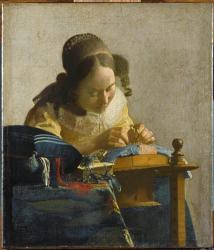- Accès directs
The Astronomer by Johannes Vermeer
Musée du Louvre, Department of Paintings
Johannes Vermeer
(Delft, 1632 - Delft, 1675)
The Astronomer
1668
Oil on canvas
H. : 0,51 cm. ; W. : 45 cm
Paris, musée du Louvre, department of Paintings, inv. RF 1983-28.
Former collection Alphonse de Rothschild ; collection Édouard de Rothschild ; Guy de Rothschild, "dation” (in payment of property transfer tax), 1983.
The Astronomer is a masterpiece by Delft-based master painter Johannes Vermeer (1632-1675). Its subject remains open to various possible interpretations; sometimes identified as a philosopher, a geometrician or an astrologist. The presence of various objects related to scientific studies – a compass, an astrolabe and a celestial globe – evoke those possible readings. Yet Andrien Metius’s astronomy and geography textbook (1621) which lies open on a page that connects the knowledge of the skies with a religious inspiration ; and the painting depicting the Finding of Moses both suggest more complex allegorical readings of this painting’s iconography.

Johannes Vermeer, The Geographer, Francfort-sur-le-Main, Stadelsches Kunstinstitut, inv. 1149.
In the 18th century, the Astronomer was systematically associated with another painting by Vermeer depicting a scholar, The Geographer (Frankfurt, Stadelsches Kunstinstitut). Although those two paintings cannot be considered as a set, they were repeatedly sold together in Holland from 1713 to 1797, before being separated for the first time during the Jan Gildemeester Jansz sale in Amsterdam in 1800. (Bascou, 2016).
These two artworks depict a shared subject, the meditating scholar. It is a recurring theme in Dutch Painting, often praising the search for scientific knowledge and its results. Yet it remains uncommon in Vermeer’s work whose vast majority of known productions depict feminine figures.
Alphonse de Rothschild was certainly receptive to this theme when he acquired the painting circa 1888 in Paris through the intermediary of Léon Gauchez – his art advisor.
After being seized by the Nazis in 1940, The Astronomer joined the Louvre’s collection in 1983 through a “dation” (in payment of property transfer tax). It now complements The Lacemaker as the only two paintings by Vermeer in French national collections. The Astronomer was the last privately own Vermeer painting and had therefore a unique status among the many paintings in the Rothschild collection. It joined the Louvre’s collection by personal decision of Guy de Rothschild (Bascou, 2016)
Laura de Fuccia, Project manager, Institut national d’histoire de l’art, 2019

Johannes Vermeer, The Lacemaker, Paris, Musée du Louvre, MI1448.
Further reading
Bibliography
– Bascou, Marc, « Les héritiers du baron Edouard de Rothschild », in Prevost-Marcilhacy, Pauline (dir.), Les Rothschild, une dynastie de mécènes en France, 3 vol., Paris, éditions du Louvre/BNF/Somogy, 2016, III, p.316-325.
– Foucart, Jacques, L’astronome et le Géographe de Vermeer, réunis après deux siècles de séparation, La tableau du mois, Musée du Louvre, Department of Paintings, n° 34, 1997.
– Vermeer et les maîtres de la peinture de genre, exhibition catalog edited by Adriaan E. Waiboer, Blaise Ducos and Arthur K. Wheelock Jr. (Paris, musée du Louvre, 22 February - 22 May 2017), Paris, co-edition musée du Louvre éditions / Somogy éditions d’art, 2017.
Online resources
See the themed research dedicated to Alphonse de Rothschild’s collection at the Hôtel de Talleyrand.






_objectId=defaultWebContent___338e2c8a-88b2-44c5-b368-390de4f08ba3.jpg)
 2 Rue Vivienne - 75002 Paris
2 Rue Vivienne - 75002 Paris




